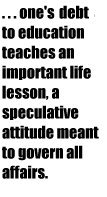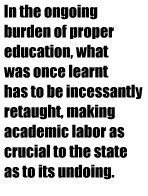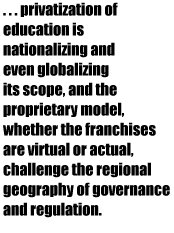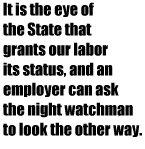Randy Martin, editor
|
1. The major legislation for postsecondary schooling in the United States, the Higher Education Act (HEA), was amended and reauthorized last year (P.L. 105-244, 1998) as it has been each year since its initial passage in 1965. At a time when education has been proclaimed to be at the top of the Clinton domestic agenda, this initiative was curiously easy to miss. The bill is largely an assortment of grants to individuals and institutions that, in the first and perhaps last instance, integrates education with the larger world of finance. Like the Federal Reserve bank flashing code to the stock market, access to higher education is signaled by modulations in what students are to pay for the money they need to attend college. Without doubt, the availability of these monies has been on the rise (notably, an additional $10 billion between 1993-95 alone--but then, so has tuition). In the 1998 HEA, interest rates on federally guaranteed student loans were cut less than one percent from their prior levels. At 7.46%, these interest rates would make an attractive mortgage, and like other adjustments for the vagaries of commerce, they can float up to 8.25% (depending on the interest rates of 3 month Treasury Bills to which the student loans are pegged). In this way, one's debt to education teaches an important life lesson, a speculative attitude meant to govern all affairs. Elsewhere in the reauthorized legislation, a Lifetime Learning Tax Credit encourages investment in mutual funds through deductions on gross income for money set aside to pay for schooling. 2. No one living in (and paying for) higher education in the United States needs to be told that the Federal government's involvement is minimal. The HEA's provisions, in keeping with a constitutional spirit that freedom is protection from harm and not entitlement, are largely supplementary to ideals of market-modeled volition. A tour through the act's verbs confirms its soft touch. It ameliorates discrimination (Title IX), assists students (Title IV), improves graduate programs (Title VII), studies "alternative financial instruments" (Title VIII) for greater market efficiencies. Likened to comparably wealthy nations where the Feds have run the universities and subsidized student attendance, the increasingly emulated US model (Slaughter, 1998) looks like tinkering around the edges. Indeed, it would seem that higher education policy in the United States epitomizes deregulation, and already embodies the hallowed reinvented governing principle of devolving power to the states. 3. The reauthorized and amended HEA does move the neo-liberal train a little further down the tracks. The education secretariat in Washington used to "approve" state accrediting agencies. Now the language in the bill is "recognition." The agencies themselves are sanctioned in their monopoly over institutional legitimation by state licensing boards, which are only mandated to inform the national offices, especially should violations of HEA titles occur. And who decides what a college or university is? The accreditation associations are voluntary and non-governmental, allowing the industry to police itself. Federal mandates do come in if a school wants to qualify for loans, grants and other aid. The original HEA stipulated that at least half the student's time had to be spent with an actual instructor, hence the term contact hours. Distance learning, touted by the Administration as increasing access to college, can't abide by such corporeal constraint. In the United States, distance-driven Phoenix University claims 90,000 students. Outside this teaching machinery, Turkey's Andolu University runs enrollments up to 500,000 (Campion and Freeman, 1998). The reauthorized legislation relaxes this stricture and provides for exemption (Title IV, Part G, Section 488) and convenes a commission composed of representatives from the Internet industry and experts on accreditation to recommend legislation (Title VIII, Part J "Web-based Education Commission"). 4. This is where social policy intersects with the design of the academic labor market. Expanded access to higher education is here seen as a compact between hardware and software. Distance learning is oriented to students already in the workforce, often in business services such as accounting (Maloney, 1999). In some measure these trends reverse the archetypal displacement of students from the workforce. Such schooling is to keep people in the labor market rather than preparing them for it by keeping them out of it. Life-long learning, Clinton's adopted phrase for educational policy, secures full employment for those already on the job. At issue as organizational energies congeal on campus is not only a contest over the conditions under which teaching occurs but, as distance learning involves staff from the fields of information technology, potential alliances between academic and other laborers who service the university in new ways. While policies that promote market-based freedom suffuse the academy, norms of autonomy will no doubt be compromised. Beyond mourning this loss and critiquing the sublation of knowledge to the world of exchange, it is important to reflect on the forces of labor brought together by the newly imposed interconnections. If education is now seeing its greatest expansion inside the labor market and information technology can give proper credit to time spent at home, then it begins to be apparent how changes in the learning industries are intrinsic to the transformation of work more broadly. In this light, the stakes become high indeed for how the academic workplace is organized, both by labor and its managers. 5. In introducing this special issue of Workplace, I want to consider the nexus of the formation of academic labor, law and social policy--or more generally, the State itself--and the way in which we may begin to talk about organizational responses that are commensurate with these developments. Taken instrumentally, policies like the HEA can make the relation between state and education appear rather mysterious, a labyrinth of tax winks and once sided recognitions that separate powers between local employers and different governmental authorities so as to make the sleight-handed State invisible and produce the principle truth effect of a market economy. Through their own voluntary associations, universities legitimate themselves under licensure from statehouses that are given a blessing from the Capitol. But the policies also provide mediating links between what may appear as discrete levels of control--not the least of which is the putative disconnect between the political and the economic. The formal separation points to a more profound interpenetration of regulatory processes that must be collated if we are to understand in its fullest extent what is meant by the term State--the whole array of practices that aim to square ongoing social change with a given societal project. 6. Approached more generally, education is the central task of the State if it is to sustain a particular configuration of society. As Gramsci pointed out, if a prevailing order is to achieve sovereignty so as to harness public participation, people must be civilized to certain patterns of domination. As he put it, "the State must be conceived of as an 'educator', in as much as it tends precisely to create a new type or level of civilization" (Gramsci, 1971, 247). In his well known conception, the state is Janus-faced. One projection is formalized through the coercive powers that underwrite politics while the other side fosters a sense of mass belonging to a partisan society. Less frequently acknowledged is his insistence that law was the regulatory aspect of political society's coercive capacity and that the hegemony relegated to private or civil society was principally a pedagogical enterprise aimed at naturalizing a prevailing order. In the ongoing burden of proper education, what was once learnt had to be incessantly retaught, making academic labor as crucial to the state as to its undoing. 7. Taken up more generally as a problem of mass education, questions of the organization of academic labor cannot be confined to the working conditions of a particular occupational type but they pose as well the matter of how the capacity to create a new type of civilization is to be mobilized. This may sound like lofty talk for those grappling with the immediacies of the academic workplace where even continuity of exposure to the most exploitative arrangements cannot be taken for granted. Surely, if connections to broader dynamics of state and society require stopping what people are presently doing to do something else, then the prospects for these linkages are dim indeed. If, on the other hand, the interdependencies of immediate working conditions, the social entailments of knowing the world, and an interest in how civilization might be developed are presently being made for us, then we are talking about a means of revaluing what we are already engaged in. At first blush, academic labor organizing is admittedly local, scaled to the geography of the employer--a community, city or state public university system, a private campus and its satellites, propriety schools and their franchises. On the other hand, privatization of education is nationalizing and even globalizing its scope, and the proprietary model, whether the franchises are virtual or actual, challenge the regional geography of governance and regulation. This contingency of the local on the national is less surprising than it seems. The autonomy of states, a legacy of colonial political architecture convenient to further postcolonial expansion, is, after all, a federal invention. No less so in education. The Morrill Acts of 1862 and 1890 granted 30,000 acres of public land for each senator and representative on Capitol hill "to promote the liberal and practical education of the industrial classes" (Lucas, 1994, 148). The Agricultural and Mechanical state colleges that resulted were not uniform in funding or curriculum, and many had initial difficulty filling their freshman classes. 8. What this centralized mandate did do, however, was establish a demand for academic labor at a national scale with a very Gramscian assignment. While the A&M's may have contributed less to national productivity than the railroads constructed during the same period, they did direct academic labor to participate in projects of colonialization and development that would enlist popular participation. There is little indication that nineteenth-century instructors who worked under the often dire conditions of land grant colleges partook of labor's Gilded Age. The first organizational response to sudden layoffs endemic to the field was an outgrowth of professional associations in the social sciences. The American Association of University Professors (formed in 1915), met anti-union sentiment among the professoriate, and keyed control over employment conditions to issues of academic freedom. 9. Perhaps the chief mark left on academic labor by the Morrill twins has been the organization of its markets. In 1870, between the two Acts, the first Ph.D. was conferred. Today over forty-thousand are granted every year--most of these by less than a hundred schools scattered about the nation. Contingency, casualization, proletarianization of academic labor make it difficult to speak meaningfully of a national market. Where there is a nationally delineated exchange for university professors, it is for their intellectual property or claims to managerial competence and not for their classroom performance. While this may fuel the reputation of an institution and allow it to circulate in other economies, its growth in student mass is driven by a different line item in the budget. While nominally in the same occupation, it would be difficult to say that the two instances of academic labor belong to the same market. This distinction between value accumulated external versus internal to the institution would tend to bracket most of the full-time professoriate with contingent labor, both of whom may share the laboratory life and publishing venues of their nationally mobile colleagues without these efforts adding to compensation. 10. The point is not one about intellectual capacity or pedagogical quality but about organizational geographies. The fact that most full-timers are stuck--voluntarily or not--in their institutions more typically engenders a disidentification with colleagues whose labor is forced to be more free. And true to form, labor tends to be cheapened when trade barriers are removed. National education policy, like the Hope and Opportunity for Postsecondary Education (HOPE) Act of 1997 meant to universalize access to two years of college, fortifies growth in the student body of regionally based schools which in turn increases demand for academic labor so constituted. This may help explain why union density is already highest in community colleges, and why organization among contingent academics is so vigorous around the country. After all, union organizing is coupled with the rationalization of labor markets so as to produce an apparent harmony of supply and demand. 11. Where state legislatures are involved as in California or the regional branch of the National Labor Relations Board, as with NYU graduate students, the mediation of the political through the manifest autonomy of the university (as self-governing) is more difficult to sustain. For the conventional professoriate, the claim of the university to be the lawgiver exerted a confounding influence on organizing drives. While the employer must be impelled to improve working conditions, for academic labor these are not simply occupational matters. The privilege enjoyed by the nationally circulating professoriate should not be dismissed out of hand (cf. Aronowitz, 1999). Rather, it should be understood for the kinds of wealth whose access and control it indexes. Teachers too often experience only the most sallow effects of the business-university nexus: managerialist strategic plans, measurable outcomes assessments, longer and denser workweeks. While much money is spent on these diversions, the vault lies elsewhere. 12. The circuits of intellectual property are not only about commodification and individuated mobility, though they are that. The loss of the university's autonomy, of knowledge for its own sake, is intellectual production that comes to us already interested, already articulated with other sites in that vast machinery now called the knowledge industry. These linkages are on display from pharmaceuticals to new media. So too are the obligations to comment and critically reflect. Suddenly the ambit of what can be called educational policy extends to the Trade Related Intellectual Property Rights (TRIPS) and Trade Related Investment Measures (TRIMS) of the General Agreement on Tariff and Trade (GATT)'s last hurrah in 1994 as well as the 1996 Communications Act. The regulatory energies required to forge the industrialization of knowledge in which higher education is now embroiled are hardly minimal. They are unprecedented. 13. The relation between the formation of labor markets and the industrialization of knowledge production needs to be considered with respect to the organizational questions for academic labor. Here one can see some rough equivalence between craft and industrial unionism as these emerged and then joined mid-century. Control over education and training allowed the crafts (and a few of their lucky cousin professional associations like the AMA and ABA--but not poor cousin Architects or Professors) to join in the regulation of supply. Social benefits came through occupational affiliation. The efforts to disavow that graduate students labor amount to occupational affiliation without benefit, debt burden without representation. Under present conditions, industrial organization adds further promise, namely, the control of mental labor as such. Industrial unions like the United Automobile Workers (UAW) accepted the division of labor required for mass production and forged among workers an integrated economy of the hand capable of continuous retooling for new models and product lines. 14. The assembly line for the mind resides in the public sphere. Like its manual antipode, it assumes not sameness but the circulation of difference. That writers for legal briefs, television series and scholarly treatises are all intellectuals is less interesting than their ability to assert a property held in common. While mental labor is conventionally individuated as freedom of thought without access to the means for producing expression and speech, the dispossession of the life of the mind has the potential to pose a social product where there had been only property. When the American Federation of Labor and the Congress of Industrial Organizations made themselves heard some folks got a New Deal, and a decade after the AFL-CIO merged in 1955, a Great Society was on offer. Of course far more organizational confluence than this was needed to bring the social benefits into view. But we also know that when the energies of unionization began to sputter, the State looked elsewhere for who to benefit. If the organization of these myriad ways of the hand encouraged the State to take better care of some bodies, we'd want to advance what the mental corollaries would be before making too much of this Cartesian divide. Perhaps it would be better not to speak of caring for bodies and minds as separable but of creating an opening for history which issues from the place where incorporation and reflection meet. 15. The political point to be made here is that one cannot get very far along the tracks of organization before the State is met head on. In the United States, labor's formal organizations have been channeled into trade and industrial unions. While the State had a presence in these, a more formal organized response to State authority has been notoriously absent for labor in this country. To think of how to encounter the State itself organizationally slips into the discussion of that third organizational form which appeared to crest before mid-century was out--the political party. 16. Certainly parties have their organizational problems. On the one hand, they can be seen to centralize what is better dispersed, and to rob mobilizations of their initiative before alliances can be given full reign. On the other hand, there are already a range of new party formations on offer, Working Families, Greens, Labor, New Party, as well as stalwarts like the Communist Party and the Socialist Workers Party. These can vie for what has become in a heavily saturated media market, an increasingly expensive commodity, a vote. 17. Fleeing parties in the direction of movements can overlook these problems, but also confuse the problem that movements form organizations of all types, including those discussed here. Rather than reserving for the term movement a certain freedom from organizational dilemmas, it might be better to name these last at the start. The craft union or professional association advances an interest that must chafe with others before the conditions that gave rise to it can be reflected upon. The industrial sector no matter how extensive its reach assumes that another lies outside it. The party names a project on behalf of a principle of development, perhaps one that will be permanently compromised when materialized in organizational form. None the less, these are organizational questions that are in many ways still and already with us. 18. If emergent expressions of academic labor are to achieve the kind of organizational hybridity suggested here, both the seemingly absent State and the nature of the work we do will have to be thoroughly interrogated. The contributions to this issue continue these efforts. Gary Rhoades' "Medieval or Modern Status in the Postindustrial University: Beyond Binaries for Graduate Students," poses the question of hybrid identity quite sharply by exploring the problems that inhere with extant models of professional labor when they are taken by themselves to be adequate. Part of the necessary urgency of any organizing endeavor is to convince people that things as they are have reached an impasse, that norms have been violated and that something must be done to address a crisis. Implicitly or explicitly, this can entail comparison to a past when times were better, a golden age for academia. Without refusing the utility of this language altogether, Fred Moten and Stefano Harney want us to reconsider not only that academic past, but how we spend our time. Theirs is an evocation of an academic speed-up that poses the ends of knowledge workers' travails in terms of a seizure of control over how time is comprised and spent. 19. The organizing of graduate students at NYU is a cautionary tale of how quickly the State appears when labor begins to organize. As the drive gets underway, the University quickly turns to the juridical apparatus (and legal expense) to challenge whether graduate students have the right to be recognized as workers. It is the eye of the State that grants our labor its status, and an employer can ask the night watchman to look the other way. The outcome of the National Labor Relations Board hearings as to whether NYU graduate students have the right to seek representation with the U.A.W. will set precedent in the private university sector. If faculty are denied this right because they have been ruled managerial employees who govern their conditions of employment, graduate students denied inclusion in academic governance mechanisms may prove the way forward for private sector unionization. Kitty Krupat offers the graduate student perspective of the hearings, while Toby Miller, a director of graduate studies at an NYU department who was asked to testify on behalf of the UAW, speaks to the ironies of a supervisory role in a putatively self-managed collectivity. Mariani Lefas-Tetenes rounds out the NYU dossier with some images and commentary on what can be seen of labor beyond the gaze of the State.
ReferencesAronowitz, Stanley. "The Last Good Job in America." 1999. In Randy Martin, ed., Chalk Lines: The Politics of Work in the Managed University. Durham: Duke University Press. Campion, Mick and David Freeman. "Globalization and Distance Education Mega-Institutions: Mega-Ambivalence." 1998. In Jan Currie and Janice Newson, eds., Universities and Globalization: Critical Perspectives. Thousand Oaks, CA: Sage, pp. 241-256. Gramsci, Antonio. 1971. Selections from the Prison Notebooks. New York: International Publishers. Lucas, Christopher. 1994. American Higher Education: A History. New York: St. Martin's. Maloney, Wendi. 1999. "Brick and Mortar Campuses Go Online." Academe 85.5: 8-24. Slaughter, Sheila. 1998. "National Higher Education Policies in a Global Economy." In Jan Currie and Janice Newson, eds., Universities and Globalization: Critical Perspectives. Thousand Oaks, CA: Sage, pp. 45-70. United States of America. 1998. "P.L. 105-244 Amendments to the Higher Education Act of 1965." www.ed.gov/legislation/HEA
Randy Martin, Pratt Institute |
|



